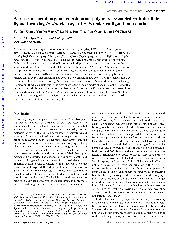摘要
A series of new metal-organic coordination complexes, [Zn(cpds)(H(2)O)(2)](n) (1), {[Zn(cpds)(4,4'-bipy)]center dot 6H(2)O}(n) (2), {[Zn(cpds)(bpe)]2 center dot 0.5(bpe)center dot 4H(2)O}(n) (3), [Cu(cpds)(2,2'-bipy)(CH3OH)]2 center dot 2H(2)O (4), {[Cu(cpds)(4,4'-bipy)(H(2)O) 2]center dot 2.24H(2)O}(n) (5), {[Cu(6-sinic)(4,4'-bipy)(0.5)]center dot CH3OH center dot H(2)O}(n) (6), [Cd(2)(6-mna) (2)(phen)](n) (7), and {[Cd(cpds)(bpe)]center dot 2.2H(2)O}(n) (8) were prepared by self-assembly of disulfide derivative of the nicotinate, 6,6'-dithiodinicotinic acid (H2cpds) with transition metal ions in the absence of different N-donor ligands (4,4'-bipy 4,4'-bipyridine, 2,2'-bipy 2,2'-bipyridine, phen = 1,1'-phenanthroline, bpe 1,2-bis(4-pyridyl) ethene, 6-sinic 6-sulfinto-nicotinate, 6-mna 6-mercaptonicotinic acid). X-Ray structure analyses of 1-8 reveal their structure ranging from the discrete unit (0D) (4), one-dimensional (1D) (1, 5), two-dimensional (2D) (7), non-interpenetrating 3D porous coordination polymers (6, 8), 2-fold interpenetrated structure (2) to a 5-fold interpenetrating framework (3), which mainly due to the differences in the bridging modes of cpds(2) and the effect of the secondary ligands. Interestingly, in the complexes 6 and 7, the starting H(2)cpds reagent is converted into new ligands (6-sinic in 6 and 6-mna in 7) under solvothermal condition via in situ cleavage of S-S bond. In addition, thermogravimetric analyses, X-ray powder diffractions and the fluorescent properties of complexes 1, 2, 3, 7, 8 have been investigated.
- 出版日期2010
- 单位西北大学
